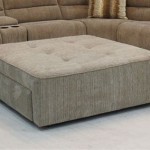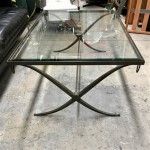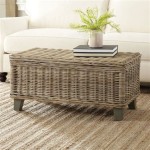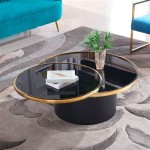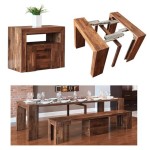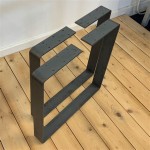What Is A Good Height For A Side Table?
The height of a side table is a crucial element in its functionality and aesthetic integration within a living space. Selecting the appropriate height involves consideration of several factors, including the height of adjacent furniture, the intended use of the table, and the overall design style of the room. A poorly chosen height can result in an uncomfortable or aesthetically jarring experience, while the correct height can provide convenient surface space and enhance the visual harmony of the room.
This article explores the key considerations for determining the ideal height for a side table, providing guidelines based on common uses and furniture pairings. Understanding these principles will help individuals make informed decisions that optimize both the practicality and aesthetics of their interior design.
Understanding the Context: Height Relative to Seating
The most important factor when choosing a side table height is its relationship to the seating it will accompany. Generally, the surface of the side table should be either at the same height as the arm of the adjacent sofa or chair, or slightly lower. This allows occupants to comfortably reach for items placed on the table without having to strain or lean excessively. If the table is too short, users will have to bend down to reach their belongings, which can be uncomfortable, especially over extended periods. Conversely, if the table is too tall, it can feel awkward and visually disruptive.
The average height of a sofa arm is typically between 24 and 32 inches. Therefore, side tables intended for use alongside sofas often fall within this range. However, it is crucial to measure the specific seating in the room to ensure an accurate match. Chairs may have varying arm heights, from as low as 22 inches to as high as 28 inches. Taller chairs, such as those found in reading nooks or home offices, may require slightly taller side tables.
It's also important to consider the cushion height of the seating. If the cushions are particularly plush or have a significant “sink-in” factor, the actual armrest height when the seating is occupied may be slightly lower than the measured height when unoccupied. This difference, though seemingly small, can affect the overall comfort and usability of the side table. Accounting for this factor ensures that the table remains easily accessible even when the seating is in use.
In situations where the side table is positioned between two different pieces of seating with varying heights, a compromise may be necessary. Choosing a height that is slightly lower than the taller seating is generally preferable to choosing a height that is significantly higher than the shorter seating. This helps to maintain a sense of visual balance and ensures that the table remains functional for both seating options.
Considering Functionality: Intended Use of the Table
The intended use of the side table also plays a significant role in determining the optimal height. A side table intended primarily for holding drinks and snacks may require a different height than one intended for reading material or decorative items. Factors such as the type of items to be placed on the table and the frequency with which they will be accessed should be taken into account.
For example, a side table used for reading may benefit from being slightly taller, allowing for a more comfortable viewing angle for books and magazines. A taller table can also accommodate a lamp, providing convenient reading light. In this case, a height that is slightly above the armrest, perhaps by a few inches, may be preferable. This elevated height can also prevent items from being accidentally knocked off the table.
Conversely, a side table used primarily for holding drinks and snacks may benefit from being closer in height to the armrest. This makes it easier to reach for items without having to lean excessively. A lower height can also help to minimize the risk of spills, as the items are closer to the lap and easier to manage. For this purpose, a height that is equal to or slightly below the armrest is generally recommended.
If the side table is intended as a decorative element, the height can be chosen to complement the overall aesthetic of the room. A taller side table can be used to display artwork or plants, adding visual interest and height to the space. A shorter side table can create a more grounded and relaxed feel. The key is to ensure that the height of the table works in harmony with the other elements in the room, creating a cohesive and balanced design.
Furthermore, the presence of drawers or shelves within the side table can influence the perceived height and functionality. A side table with a drawer may require a slightly taller profile to accommodate the drawer mechanism. Similarly, a side table with a shelf may benefit from being slightly taller to provide adequate clearance for items stored on the shelf.
Matching Style and Scale: Harmonizing with Room Design
The overall style and scale of the room should also influence the choice of side table height. In a room with high ceilings, a taller side table may be more appropriate to maintain visual balance and prevent the table from feeling dwarfed. Conversely, in a room with low ceilings, a shorter side table can help to create a sense of spaciousness and prevent the room from feeling cramped.
The architectural style of the room can also play a role. In a modern or minimalist space, a sleek and low-profile side table may be preferred. In a more traditional or rustic space, a taller and more ornate side table may be more appropriate. The side table should complement the existing design elements of the room, creating a cohesive and harmonious aesthetic.
Consider the scale of the other furniture in the room. A large and bulky sofa may require a larger and taller side table to maintain visual balance. A smaller and more delicate chair may pair better with a smaller and shorter side table. The goal is to create a sense of proportion and harmony between the furniture pieces, ensuring that the side table does not feel out of place.
The material and finish of the side table can also influence its perceived height and visual impact. A side table made of a dark and heavy material, such as wood or metal, may appear taller and more substantial. A side table made of a light and airy material, such as glass or acrylic, may appear shorter and less visually intrusive. The choice of material and finish should complement the overall design style of the room and enhance the aesthetic appeal of the side table.
When selecting a side table, it is beneficial to consider the existing color palette of the room. A side table with a contrasting color can draw attention to itself, potentially emphasizing its height. A side table with a color that blends with the surrounding furniture and décor can create a more seamless and integrated look. The choice of color should be deliberate and contribute to the overall visual harmony of the room.
Ultimately, the ideal height for a side table is a balance between functionality, aesthetics, and personal preference. By considering the height of adjacent seating, the intended use of the table, and the overall design style of the room, individuals can make informed decisions that optimize both the practicality and visual appeal of their interior spaces.
Before making a final purchase, it can be helpful to use painter's tape to mark out the dimensions of potential side tables on the floor. This allows individuals to visualize the size and scale of the table in relation to the existing furniture and assess the impact of the height on the overall layout of the room.
In addition, consider the potential for future changes in the room. If there is a possibility of rearranging the furniture or replacing existing seating, it may be wise to choose a side table height that is versatile and adaptable to different configurations. This ensures that the side table remains functional and aesthetically pleasing even as the room evolves over time.

End Table Height How Tall Should Your Side Be Ca Bedroom Tables

End Table Heights

End Table Heights

Nill Fremont Nightstand Oak Walnut Furniture

Considering Scale Elegant Bedside Tables Table Lamps Side Height

The Ultimate Coffee Table Size Guide Apt2b

Nill Elena Solid Wood Side Table New Wenge Furniture

Buy Kawachi Portable Height Adjustable Laptop Study Table Bedside Patient Tray Overbed Beige At Best S In Jiomart

Wooden Height Adjustable Table Hospital Bed Side

Picking The Perfect Side Tables For Your Living Room
Related Posts

